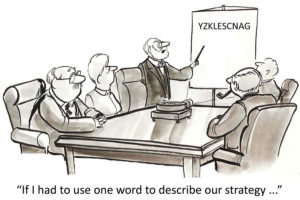I See (or hear) the Same Thing
| …but it means something different to you. Do you ever feel like you are hearing words that are familiar but are being used completely different that you expect? Have you ever explained something clearly in what you deem to be plain language only to get a completely different action? Common language isn’t so common. Even when a single language is the standard it often is used differently. One of the greatest causes of frustration and misunderstanding in organizations is lack of clarity and consistency in language. There are words in our business lexicon that we use, repeat and people nod their heads in agreement. For example, “we need to increase engagement” could mean that one leader wants to put a strategy together to improve the relationship between leadership and employees. Another leader may say the same thing in response to an employee survey that said communication was lousy and they need to take action. Tips for creating language clarity: 1. Decode the meaning – cultural context is critical. We’ve worked with organizations who maintain an internal lexicon of the terminology they use. There are abbreviations that change depending on the organization or industry that you are working with. For example, ETA can mean estimated time of arrival, easy to assemble or electronic travel authority. The site www.abbreviations.com illustrates the challenge of the multiple meanings behind most abbreviations. Before you assume that you know what something means, ask questions and get past the assumptions that could create misunderstanding. 2. Create Consistency – Get clear on the definition of common words by getting everyone to agree on the definition and documenting it. A funny example comes from our trip to South Africa. We shared a group photo with a friend and his observation was that we all look “pissed.” That is a word we understand to mean “angry.” In his mind he was saying we looked like we were having tons of fun and were drunk. Very different meaning for the same word. This happens every day in organizations where people use words like strategy, engagement and innovation. These are all great words that mean something completely different from one person to another. 3. Simplify, simplify, simplify and then repeat, repeat, repeat. These are complimentary suggestions. Although variety may be the spice of life, it is the enemy of clear language. Once you’ve simplified your language and settled on the terms you are going to use, it’s time to repeat them. Use them often in order to reinforce them. While diversity of thought is tremendously beneficial, it can also bring a diversity of definitions. Think of the word strategy. To some people it means a plan of action. For other people it means a framework that defines the direction of an enterprise. When setting strategy we’ve found that the first challenge is often differing definitions. It’s hard to create strategy when it means different things to each participant in the strategy session. So simplify and then repeat to reinforce what you mean. 
“If you talk to a man in a language he understands, that goes to his head. If you talk to him in his language, that goes to his heart.” ~ Nelson Mandela So learn the language of others (what their words mean) and you will be a more impactful communicator, leader and bridge builder. |

